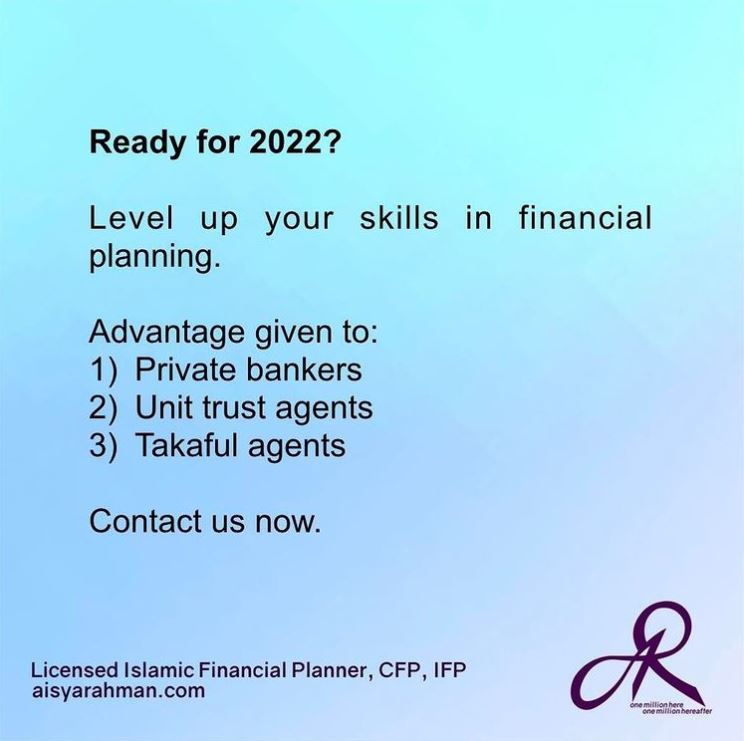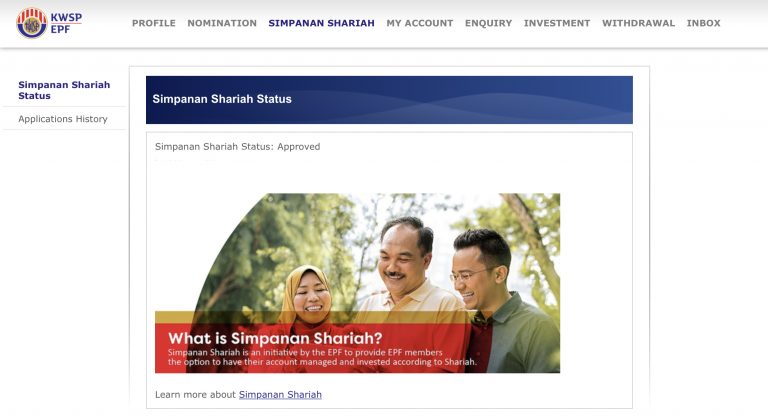How to become a Licensed Islamic Financial Planner in Malaysia.
Are you currently a private banker, a unit trust agent or a takaful agent?
Have you ever felt stuck, where your clients wanted solution B, but due to your limitation of being attached to a single solution provider, you could only offer solution A, and not B, C, D E?
I was in that position before. I felt annoyed whenever the solution that I had was constantly being compared to competitors in the industry. I honestly felt stuck myself, and have wondered was this the only path for me to grow in the financial services industry?
Then one day, during one of the unit trust classes that I joined in 2016, my trainer told me about how the title “Financial Adviser” and “Financial Planner” were being regulated and could only be used by those who were licensed directly under the regulators. At that moment, I thought, wasn’t I a financial planner myself since I was attached to a unit trust provider? (Answer: NO).
If you don’t already know the answer, a private banker or unit trust agent or takaful agent or estate planner are not allowed to call themselves the above titles (Financial Adviser and Financial Planner) until they have fulfiled all of the requirements by Bank Negara and Securities Commission.
Also, I hold dual licenses, Licensed Financial Planner and Licensed Islamic Financial Planner. This article is written based on my own experiences of transitioning from unit trust agent, to certification, to licensing to practitioner stage.
So, if you’re an agent yourself and have always wanted to pursue career growth other than the typical way of climbing the agency ladder (agent > supervisor > manager > group agency manager), then you’re on the right page. Read til the very end.
Step 1: Recognising your passion and interest
It takes alot of courage to know that what you want is different than the rest of the folks in your agency.
When I was still a unit trust agent, I was already at supervisor rank with few downlines. Initially, I thought I wanted to be like everybody else who dreamt of becoming a group agency manager. A short-lived dream – and hey, that’s okay!
Step 2: Certification
Enrol in the right course:
i) Either pursue all 4 modules in Certified Financial Planner (CFP) or 4 modules in Islamic Financial Planner (IFP) under FPAM, or
ii) Pursue all 7 modules in Registered Financial Planner (RFP) or 7 modules in Shariah Registered Financial Planner under MFPC.
Both certifications under FPAM and MFPC are recognised by regulators to take you to the next step – licensing. CFP is recognised globally, whereas the rest are recognised locally. Note: pursue what works for you, your budget and your timing.
To those with relevant Degree and Masters (ie: exposure to finance, accounting), coupled with number of years in the financial services industry (ie: banker, agent), then you can contact FPAM or MFPC and see if you qualify for exemptions. You can skip many modules and jump straight into CFP Challenge Status / IFP Challenge Status under FPAM, or RFP Capstone / Shariah RFP Capstone under MFPC.
For me, I sat for both CFP Challenge Status and IFP Challenge Status under FPAM due to my years of experience in the financial services industry and my education background (relevant Masters qualification). It saved me time and money, but it was HARDWORK because I remembered taking many months off just to study. Grateful I was already working on my own when I was pursuing CFP and IFP certifications. I cannot imagine the amount of stress I would have needed to endure if I was still a full time employee in the bank.
FYI, I completed my certification with IFPA (Segi Subang). Highly recommend them! Great lecturers too!
Note: Having CFP / IFP / RFP / Shariah RFP does not make you a Financial Adviser and Financial Planner. It had to be in red, just because. This is similar to those having ACCA but did not pursue to become a charted accountant, or a medical graduate who did not pursue to become a doctor.
Step 3: Licensing preparation
Once you’ve passed all modules, regardless if you take the route of FPAM or MFPC, you ought to ask yourself if you shall stop there, or you want to progress to the next level.
Many agents stopped after certification because they’ve worked so hard to climb the agency ladder – passive income is good, downlines are many, clients are aplenty. If this is your calling (to remain as an agent and grow your team), good. There is no right or wrong.
For the rest who feels like they want to become fully licensed, then this is where your next hustle comes in. You ought to survey for a financial planning firm. Or to make your life and years ahead easier, you can join me 🙂
Once you’ve identified which firm you want to join, they should be able to guide you on licensing procedure, joining fee to pay to the financial planning firm, profit sharing ratio for commissions earned. If you are agreeable, there are paperworks to sign.
Step 4: Resigning from your current bank / unit trust / takaful provider
There is a standard cut off period (to be discussed with the financial planning firm) on when you should be fully licensed. Which means, the step to be taken before full licensing is to officially tender your resignation from your current bank / unit trust / takaful provider. Resignation takes time as your current bank / unit trust / takaful provider has to terminate your licensing with regulators (such as PIAM, LIAM, FIMM). So work backwards and plan properly.
Before you resign, I highly recommend you informing all of your clients about your transition. At first, they wouldn’t understand. They would usually assume that you are moving to another provider (meaning another competitor). Some clients may choose to remain with your current unit trust provider (which means they’ll be taken care of by your upline once you resign). But those who choose to follow, they will be handsomely rewarded and I say this from my own experience of managing 8-figure asset under management.
For majority of the takaful providers, they allow retagging of your takaful agent code to financial planner code. So don’t be afraid, your clients are still yours.
Step 5: Becoming a Licensed Financial Planner / Licensed Islamic Financial Planner
Once you have officially resigned, the financial planning firm will carry on with the rest of the licensing procedure. It can take up to a month for you to be fully licensed.
Utilise this waiting time to continue informing your other clients and to also attend for training.
I remembered going for training almost every other day for one year with my firm. Due to this sacrifice and investment made in knowledge, I was able to empower myself and my clients on the limitless solutions and growth opportunities. As a practitioner myself, I was blown away with the possibilities of materialising my financial goals. I was able to see that achieving financial freedom was truly possible. If it was going to be possible for me and my family, heck, I am gonna make it possible for each and every of my client.
Step 6: Applying what you’ve learnt
Unlike being an agent where one could just pursue it part time for “side income”, becoming a Licensed Financial Planner / Licensed Islamic Financial Planner is a full time commitment. You are not allowed to be an employee elsewhere, this is as per the requirements by regulators.
Having a supportive financial planning firm and colleagues in the firm who share the same goal matter. Here, there is no such thing as upline or downline. Everybody is equal. We share case studies, we continue to speak to industry providers to continuously fill the gaps and improve our services.
On the products side, since most of those reading are either unit trust agents or takaful agents, here’s something that you should know. As Licensed Islamic Financial Planner, you and I have access to provide these solutions to our clients:
1. More than 150 Shariah unit trust funds from multiple asset management companies in Malaysia
2. More than 20 Shariah PRS funds from multiple asset management companies in Malaysia
3. Access to all the GIANT takaful providers
4. Offshore Shariah portfolio
5. Shariah stocks, ETFs and more!
However……. The reality is………
Some of those who pursued the certifications (up til Step 2) didn’t move forward til Step 6. That’s why in Malaysia, there are just slightly above 1,000 Licensed Financial Planners / Licensed Islamic Financial Planners combined, as at 30 Oct 2021. I report these statistics with pride because I know what each one of us have sacrificed to get to where we are today. It took alot of courage, hardwork, perserverance including going broke for awhile just to fulfil step 1 to step 6! Hence why the first financial plan that you ought to create and complete is for YOURSELF!
Speaking from my own experience, I honestly am glad I took the leap of faith to become a Licensed Financial Planner and Licensed Islamic Financial Planner. The type of portfolio I am building for my clients, their loved ones and I are different, beyond than what I could have ever imagined. We no longer talk about unit trust and takaful. Our conversations are deeper, more meaningful and each goal is designed intentionally.
I have now expanded my scope than just becoming a Licensed Islamic Financial Planner. I am also now a HRDF certified trainer, which means I want to elevate my practise to the next level. I want to focus on empowering more Muslims to be financially literate because life is short, I want to pass on my knowledge and legacy to the next generation. Hence why to be blunt, I am recruiting, so that together, we can empower even larger group of audience. Think of this as your saham akhirat. I am leveraging on saham dunia to build my saham akhirat. FYI, I love stocks trading too.
If this fits your cuppa, I invite you to leave your details or connect with me in any of my platform. All the best for 2024!
Schedule for a discovery call today.








